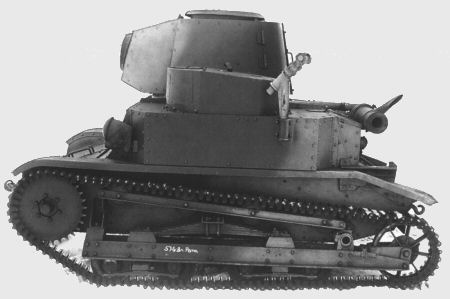This article is a supplement to the Polish tankettes TK-3 (TK) and TKS, presenting their experimental variants TKW and TKS-B. Experimental self-propelled guns TKD and TKS-D are described on a separate page, so is an auxiliary equipment for tankettes, excluded from this page.
TKW tankette
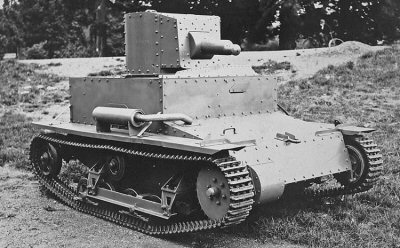 |
| One of Vickers Carden-Loyd Patrol Tank variants (an engine and transmission on right side). |
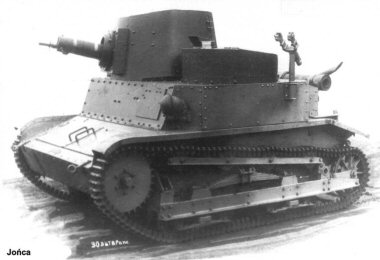 |
| The TKW with early (up) and late turret (below). The first vehicle has wz.30 machine gun and the driver's Gundlach periscope (apparently removed in the later vehicle). [AJ] |
 |
From 1931, the Polish Army began to be equipped with tankettes – small turretless reconnaissance tanks TK-3 (TK), developed in Poland, modelled after the classic British Carden-Loyd Mk.VI, although not being its direct copy. Thanks to mounting an armament – a machine gun in a hull, the tankettes had low silhouette, making them difficult to spot and hit, and were cheaper to produce. On the other hand, a major drawback of such weapon arrangement was limited angle of fire. The whole vehicle had to turn to fire at sides, and quick engagement of some targets was difficult or impossible. It was especially notable in tankettes used on rails as armoured draisines, which could fire along the track only. Trying to find a solution, at the outbreak of 1931/32, the Armoured Weapons Construction Bureau of the Military Engineer Research Institute (BK Br.Panc. WIBI) in Warsaw started to design a tankette with a revolving turret, named TKW (W for "wieża" = turret).
It realized a similar idea, as the other British design of that time, the Vickers Carden-Loyd Patrol Tank. It is not clear, if the Carden-Loyd design had any influence, considering, that it was designed at similar time – in 1932, and had different, more rational layout (the engine was on one side, and the crew on the other; the gunner with his turret was placed behind the driver, what enabled a full traverse). However, the VCL Patrol Tank appeared unsuccessful, and few were sold (two to Denmark are known). Similar layout was repeated in more numerous Japanese Type 94 TK tankette (the designation similiarity with the Polish one was obviously accidental).
The TKW construction was based upon the TK-3 chassis. Its combat compartment was lowered, and there was a small turret added above the commander, armed with one machine gun in an universal ball mounting with a telescopic sight. Unlike the British design, the TKW had the engine between the crew seats, like the basic tankette. Turret had sides 8 mm thick, riveted to a frame; it had a hatch on the roof and in a rear curved plate. The driver's head was protected with a big box hood, fitted with a reversible tank periscopeWikipedia for all-around observation (invented in Poland, by Rudolf Gundlach). It also had a two-part observation hatch in front and an access hatch on the top. The periscope was probably fitted in January 1934 only, along with a modification of the driver's hood. In the first version there apparently was a two-part roof hatch opening to the sides; in the final version replaced by a single hatch opening towards front, in a different cover. The commander had vision slots only in the turret.
At first it was decided to build six experimental tanks. The prototype was converted from the TK tankette nr. 1164, of the first trial series, made of mild iron plates, at the end of 1932. Due to a lack of armour, it was not combatworthy. According to publications, it was first armed with a standard 7.92 mm air-cooled wz.25 Hotchkiss machine gun, however there are no photographs with the wz.25 MG fitted, so it is not clear if it was armed at all. In October 1933, more reliable water-cooled 7.92 mm wz.30 (Browning) machine gun was mounted. The trials conducted that month revealed turret faults, like: a lack of space, bad stability of the gun mounting, poor observation conditions, and especially poor ventilation. As a result, the improved turret was developed in 1934, with a lengthened box-like front part, and ventilation slots under the hatch on the top. Judging from the mounting type, it returned to the standard air-cooled wz.25 Hotchkiss machine gun, although there are no photos known of the improved TKW with the machine gun fitted. The exact chronology of turret changes is unfortunately not clear.
Further field trials in summer 1934 showed, that the design was not succesfull at all. Its right side was overloaded and a centre of gravity was too high. The crew members could not communicate with each other, and were separated with the engine in addition. The driver's hood limited turret rotation to 306°, while the turret obstructed the driver's field of view. In February 1935, the TKW design was abandoned and a production of further five tanks was cancelled. It was evident, that a bigger tank was needed to fulfil reconnaissance tasks, which could be fitted with a turret without such problems and carry more adequate armament. In that period, the works upon bigger and more capable reconnaissance tank 4TP started. The TKW prototype was given to the Armoured Weapons Technical Research Bureau (BBT Br.Panc.). In February 1935 it was used for testing new rubber and metal tracks I.F.K. 15 of Stefan Kardaszewicz design, but they appeared a failure (is is interesting, that during trials it had the older turret again). Later the prototype was broken up. The newer turret was apparently adopted in the PZInż.130 amphibious tank prototype in 1936/37.
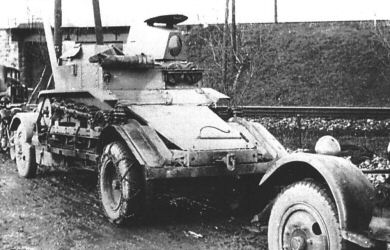 |  |
| A mysterious TKW prototype upon an autotransporter. It has been suggested in publications, that it has some interim turret variant, but we suspect, that this may be the earliest vehicle in fact (the driver's hood has different construction, with the hatch opening to the sides). | The TKW during tests of S. Kardaszewicz's tracks, 5 February 1935. For unknown reason, the vehicle returned to the older turret, and lacks the driver's hood.
|
Contrary to some plastic models, the TKW was not meant to be fitted with 20 mm cannon wz. 38 model A (FK-A). When the FK-A was manufactured, the TKW program had been abandoned for a long time. Besides, it would be difficult, if not impossible, to fit this cannon with a gunner into the existing small turret. There were no designations: "TKW I", "TKW II" either.
TKS-B tankette
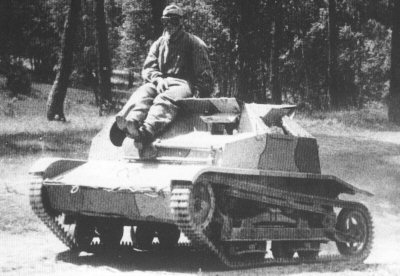 |
| The TKS-B during trials in summer of 1936, without a weapon mounting. Note the older camouflage scheme, with an interesting pattern of patches. [1,3] |
The works upon a light artillery tractor based on the TKS (TK-S) tankette (later C2P tractor) showed, that the TKS chassis and steering system is unsuitable for towing guns. First improvement to the tractor was lengthening of suspension by making rear idler wheels bigger, so they became also last roadwheels. Both TK and TKS tankettes made turns simply braking one track, thanks to a differential mechanism. In 1935, Polish designers decided to add side clutches to the transmission of the tractor. At the same time, these improvements were tested in one TKS tankette, converted in 1936 – it was the tankette nr. 1510, of the first series, made of mild iron plates (some sources quote erroneous date 1937). The conversion was designated TK-SB or TK-S-B (for sprzęgła boczne = side clutches) – an established form in modern publications is however TKS-B.
The TKS-B took part in a test drive on 1464 km route in June-July 1936. During trials, its average speed was 5 km/h higher over the TKS, both on roads and off-road. It was also easier to steer, and consumed less fuel. Longer chassis improved crossing capability. Its traction performance improved greatly and trials were successful, but a production of the TKS was ending at that time, and they were not considered modern fighting vehicles anymore. It was estimated, that a conversion would cost as much, as 10,000 złoty (compare prices), therefore on 17 September 1936 the conversion of produced TKS tankettes was considered unworthy. It was believed according to older publications, that the prototype TKS-B was next converted to a tank destroyer TKS-D[1]. However, newest sources reveal, that both TKS-D were converted from tractors nos. 8897 and 8898[7]. Therefore, a fate of the TKS-B prototype remains unknown.
Contrary to the 1/35 Mirage plastic kit, the TKS-B was not fitted with 20 mm cannon FK-A, and the only prototype was not armoured and probably unarmed.
 |
| Polish experimental tankettes (drawing Janusz Magnuski) [5] |
Models
Links to Scalemates website. In italics are wrong names:
1/72:
- -
Part (A006-72) - TKW
- Excellent high-tech kit from the Polish producer, made of photoetched brass with few resin supplements. No interior. Many small and subtle details.
- - RPM (72504) - TK-W I
- - RPM (72510) - TK-W II
- Plastic models, basing (wrongly) on the TKS chassis. First 72504 was a limited edition model, sold without a box, enabling to build late TKW prototype or fictitious TKW-II with 20 mm cannon, later both kits were separated.
- -
FPW Model (72013) - TKW
- -
FPW Model (72014) - TKW II
- New (2019) resin Polish conversion sets, for FtF plastic models (included). There is also pure resin conversion set 72015, without a chassis. TKW II is fictitious vehicle with 20 mm gun.
1/35:
-
- Mirage (35413) - TKS-B
- The Polish producer. The kit can be built as a regular TKS, TKS with 20 mm gun, or prototype TKS-B. Vinyl tracks, mediocre plastic quality, but good accuracy. No interior nor open hatches.
- - RPM (35034) - TKW I - (properly: TKW)
- - RPM (35035) - TKW II
- Medium quality plastic models of late TKW prototype or fictitious TKW-II with 20mm cannon, with an interior
1/25:
- -
Orlik nr 055 - TKW
- Cardboard model
Other parts:
Sources:
1. Janusz Magnuski: Karaluchy przeciw panzerom; Pelta; Warsaw 1995
2. Janusz Magnuski, Andrzej Kiński: Tankietka TKW in Poligon nr. 3/2006
3. Mirosław Zientarzewski: Czołg rozpoznawczy TK-S. Zarys rozwoju konstrukcji. "Militaria i Fakty" nr 31 (6/2005)
4. Janusz Magnuski: Czołg rozpoznawczy TKS (TK); TBiU nr. 36; Wydawnictwo MON; Warszawa 1975
5. Jędrzej Korbal: Czołgi TK-3/TKF i wyposażenie, series: Wielki Leksykon Uzbrojenia - wydanie specjalne 3/2019, Warszawa: Edipresse Polska 2019
6. Jędrzej Korbal: Ciągnik C2P i wyposażenie, series: Wielki Leksykon Uzbrojenia - wydanie specjalne 1/2018, Warszawa: Edipresse Polska 2018
AJ - photos from a collection of Adam Jońca
Update history:
15. 12. 2019 - update to models and minor improvements
05. 07. 2019 - small update to models
09. 06. 2019 - page modernized, updated text, added photos, excluded a page about special equipment
07. 08. 2008 - revised text, added photos
20. 04. 2007 - new page
[ Main page ] [ Polish armour ]
[ Polish artillery ] [ Steel Panthers ] [ Links ]

You can mail
me with question or comments - corrections or photographs are welcome.
All photos and pictures remain the property of their owners, some are public domain. They are published in non-commercial educational and research purpose.
Text copyright to Michal Derela © 2007-2019.

